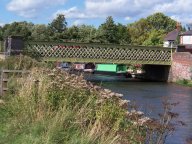
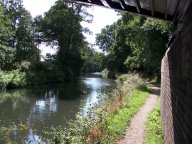
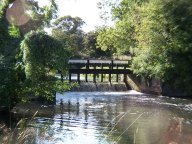



Shalford is a small village south of Guildford in the County of Surrey.
Shalford lies on the North Downs Line, connecting Guildford to Redhill. Shalford is also connected to Guildford by the River Wey.
The Domesday Book, records Shalford as having three watermills, of which only one, dating from the 18th century, survives today.
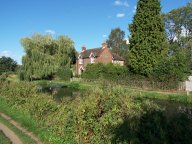 Shalford Mill, now owned by the National Trust, lies opposite the Sea Horse. Shalford Mill was saved for the National Trust by the activities of the Ferguson Gang.
Shalford Mill, now owned by the National Trust, lies opposite the Sea Horse. Shalford Mill was saved for the National Trust by the activities of the Ferguson Gang.
The Ferguson Gang were a masked gang that went around the countryside making observations of England's treasures. Their activities first came to light when in the 1930s, over a period of a couple of years, they made available the funds to enable the National Trust to purchase Shalford Mill. This was not the limit of their generosity. They also made available funding for the purchase of Newton Old Town Hall on the Isle of Wight and bought up a stretch of the Cornish Coast to save it from developers.
The River Tillingbourne, which powers Shalford Mill, flows into the River Wey at Shalford, adjacent to the parish church. The River Wey at Shalford was the northern limit of the now disused and derelict Wey & Arun Canal.
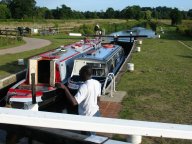 The ill-fated and short-lived Wey & Arun Canal, connected the River Arun at Arundel to the River Wey at Shalford. Shortage of water meant the canal was never a success. The strategic importance of the canal cannot be overstated as it provided a route from London to the South Coast, boats could avoid going around the coast where they risked being attacked by the French.
The ill-fated and short-lived Wey & Arun Canal, connected the River Arun at Arundel to the River Wey at Shalford. Shortage of water meant the canal was never a success. The strategic importance of the canal cannot be overstated as it provided a route from London to the South Coast, boats could avoid going around the coast where they risked being attacked by the French.
Shalford has three pubs, the Sea Horse, Queen Victoria and The Parrot. The landlord of The Parrot cannot be bothered to open on a Sunday evening.
The Sea Horse is an excellent pub that used to serve Gales Ales and country wines. Its name dates from its use as a brothel, a derivation of Sea Whores. Sailors en route from from London to Portsmouth would call in for sex with the ladies.
King John granted a charter for what became known as "the Great Fair of Shalford". King John granted the charter to the rector, and for a long time the fair was held in the churchyard. It then relocated to Shalford Common, where in its heyday, it was said to have covered 140 acres and attracted merchants from across the country.
Gazetteer of Market and Fairs in England and Wales to 1516:
(Grant: other) vfm, Assumption (15 Aug); gr 1199x1216, by K John to John de Guildford, parson of Shalford (VCH Surrey, iii, p. 110). In 1287, the fair was said to have been granted by K John to be held in the ch yard of Shalford (erroneously recorded as ‘Stratford’) subsequently being moved outside on account of the growth of population (CIM, 1219-1307, no. 1409). This was one of the most important fairs in the county, but was subsequently eclipsed by the fair at St Catherine’s Hill, Surrey (q.v.) (VCH Surrey, iv, p. 427).
John Bunyan, author of The Pilgrim's Progress, is reputed to have once lived in Shalford in a cottage on the common. It is thought he may have drawn his inspiration from the fair, and from the ancient route known as the Pilgrims' Way, which passes nearby, on its way from Winchester to Canterbury.
The common is now used for cricket. A very famous cricket match took place in 1877, when on one side a team of 11 Mitchells, all related, played against 11 Heaths, all from the same family.
The common has recently become infamous for the practice of 'dogging', meeting with strangers to have sex. The name is believed to be derived from 'I'm just popping out to take the dog for a walk'.
According to past entries in Wikipedia, not the most reliable source on the planet, feral homosexuals are running rampant in Shalford!!!!
The original church, mentioned in the Domesday survey, no longer exists. An early Victorian church now stands in its place. St Mary's Church was built in 1846. In the church is a Tudor brass from an earlier church and a commemorative tablet to Colonel Frederick George Shewell.
Colonel Frederick George Shewell fought at Alma and Inkerman. He led his regiment in the Charge of the Light Brigade at Balaclava, and by his coolness and bravery, saved the remnants of the regiment from total destruction.
One of the oldest properties in Shalford, Shalford House, dates back to the Tudor period and features in the dining room a carved stone fireplace dated 1609, the walls being hung with old family portraits. Other rooms have fine panelling and magnificent old fireplaces. The drawing room is a good example of the Adam period. The house belonged to the Austen family for 300 years.
Consisting of around 40 singers, the Shalford Choral Society was founded in 1905 in order to participate in the first Leith Hill Musical Festival and have remained an active and often very successful participant ever since. Held annually in Dorking, the Festival is one of the country's leading choral events.
The Pilgrims Way, following the North Downs, crosses the River Wey between Guildford and Shalford. There used to be a ferry boat crossing, there is now a bridge. Where the Pilgrims Way descends to the River Wey down a little lane, a small stream issues forth from the chalk and flows into the Wey. On the opposite bank is Shalford Park. Mid-summer, Shalford Park hosts the one day Ambient Green Picnic.